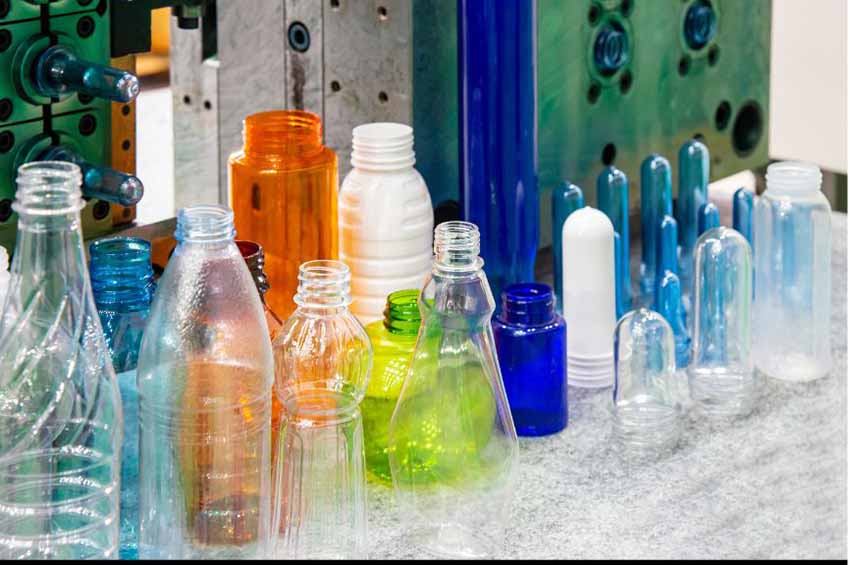So, you’re interested in knowing about the plastic water bottle you’re holding. Great thinking! Knowing this will help you understand the impact of plastic in every aspect of our lives.
This article will answer everything from the basic question ‘How are plastic water bottles made? What raw materials are used here? What environmental concerns does it raise?’ and so on.
Let’s scroll down to know every answer in a detailed manner.
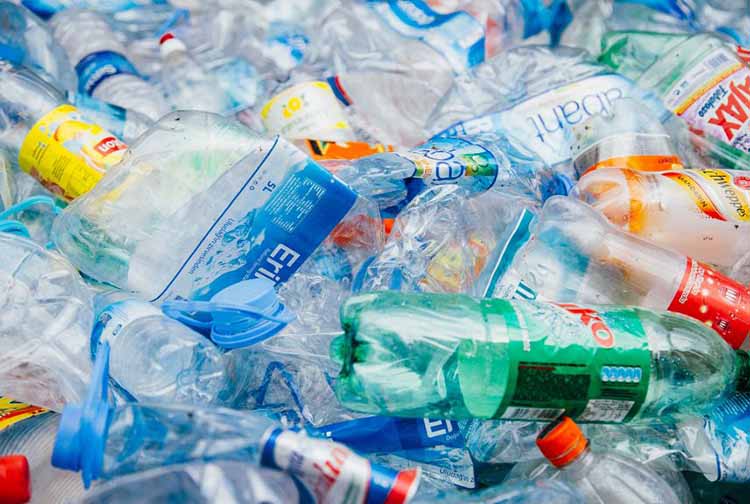
What Are The Raw Materials of Plastic Water Bottles?
Plastic goes through a long and complex process to become bottles for liquids like water, soda, shampoo, milk, and motor oil. It’s also used for dry products like nutritional supplements and medications.
In its raw form, plastic contains various organic polymers, including polyethylene and ethylene. When you heat plastic, it softens, and you can easily mold it into different shapes before it cools and hardens into its final form.
Manufacturers usually make plastic bottles from the materials below.
PET (Polyethylene Terephthalate)
PET is a polymer primarily made from petroleum hydrocarbons. It forms through a chemical reaction between the monomers terephthalic acid and ethylene glycol.
Terephthalic acid reacts with methanol to create PET plastics. This produces dimethyl terephthalate and water. The product then reacts with ethylene glycol at 305 degrees Fahrenheit, yielding bis(2-hydroxyethyl) terephthalate and methanol.
In the final stage, the magic happens! The polymer forms and releases another molecule in the process. This part is known as condensation polymerisation. It takes place in a vacuum at 530 degrees Fahrenheit.
It creates long chains of PET and ethylene glycol. The ethylene glycol is continuously removed and recycled back into the process to make even more PET.
Once the PET mixture reaches the right thickness, it’s quickly cooled down to prevent any discolouration or degradation. Later, manufacturers use it to produce plastic bottles.
Advantages
- PET bottles are easy to carry and transport, reducing shipping costs and energy usage.
- The FDA approves PET for food and beverage contact due to its safety and non-toxicity.
- PET is strong and resistant to impact, making bottles less likely to break.
- PET is widely recyclable, and recycled PET (rPET) can be used to produce new bottles and other products.
Disadvantages
- Improper disposal of PET bottles can cause environmental pollution and affect wildlife and ecosystems.
- Exposure to sunlight and high temperatures can cause PET to degrade and question its safety.
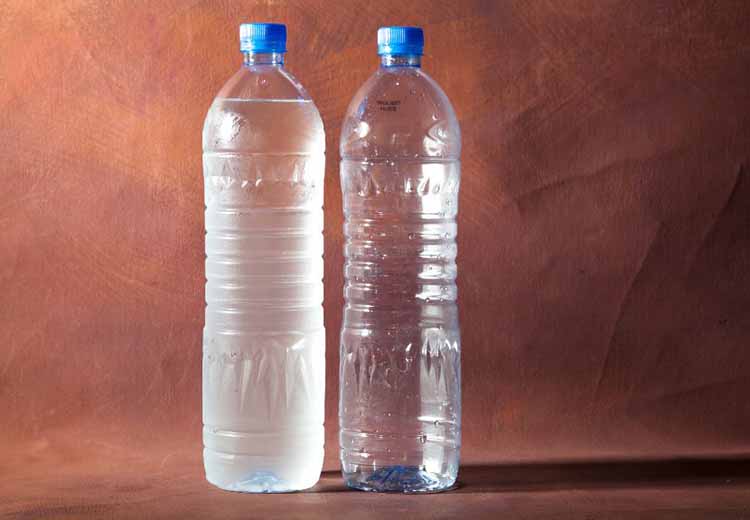
Recommended: Best Insulated Plastic Water Bottle
HDPE (High-Density Polyethylene)
High-density polyethylene (HDPE) is a cost-effective material that provides an excellent moisture barrier. This feature makes it the most commonly used plastic for bottles. It’s marked by resin identification code 2.
HDPE comes from petroleum found deep underground. It’s strong, resists many solvents, and has a great density-to-strength ratio. This makes it ideal for making reusable and recyclable bottles. Besides bottles, HDPE is also used to make pipes, fireworks, lumber, and plastic bags.
Advantages
- HDPE is widely recyclable and can be reused to make new bottles and other products.
- It’s resistant to a wide range of chemicals, which makes this material safe for storing various liquids.
- HDPE is strong and resistant to impact, making it ideal for robust and long-lasting bottles.
- HDPE provides an effective barrier against moisture, which helps preserve the quality of the bottle’s contents.
- Approved by health authorities, HDPE is safe for food and beverage contact.
Disadvantages
- HDPE bottles are heavier than PET bottles, which increases transportation costs.
- They can be less flexible than PET bottles, which may affect grip and portability.
LDPE (Low-Density Polyethylene)
LDPE bottles are widely used for packaging a variety of personal care products like lotion, shampoo, and more. This type of plastic is perfect for packaging needs that demand both flexibility and strength.
Like HDPE, LDPE is less rigid, which makes it ideal for squeeze bottles, plastic bags, six-pack rings, and other similar items. In its pure form, LDPE resists chemicals, repels microorganisms, and does not release toxins when used for food storage.
However, recycled LDPE is not safe for food contact.
Advantages
- LDPE is very squeezable and conforms easily, offering a comfortable grip.
- LDPE provides a good barrier against moisture, although not as good as HDPE.
- This material can absorb shocks and impacts without cracking, enhancing the bottle’s durability.
- LDPE bottles are lightweight, reducing transportation costs and making them easy to handle.
- It resists some chemicals but may not be suitable for all beverages.
Disadvantages
- LDPE can warp or melt at higher temperatures. So, it’s not ideal for hot liquids.
PP (Polypropylene)
Polypropylene is commonly used for single-serve items such as yoghurt cups. It is also found in reusable containers designed for storing leftovers.
Besides being one of the materials approved by the FDA for food contact, polypropylene is microwave-safe and nonvolatile. It does not react with any liquid, acidic, or basic food.
Advantages
- PP is strong and impact-resistant, and it offers good protection against cracks and breakage.
- It resists many chemicals and doesn’t leach into water, promoting safety.
- It can withstand higher temperatures than LDPE, making it suitable for hot beverages.
- PP is recyclable, contributing to environmental sustainability efforts.
Disadvantages
- Polypropylene is not as clear as other plastics like PET, which might be less appealing for certain uses.
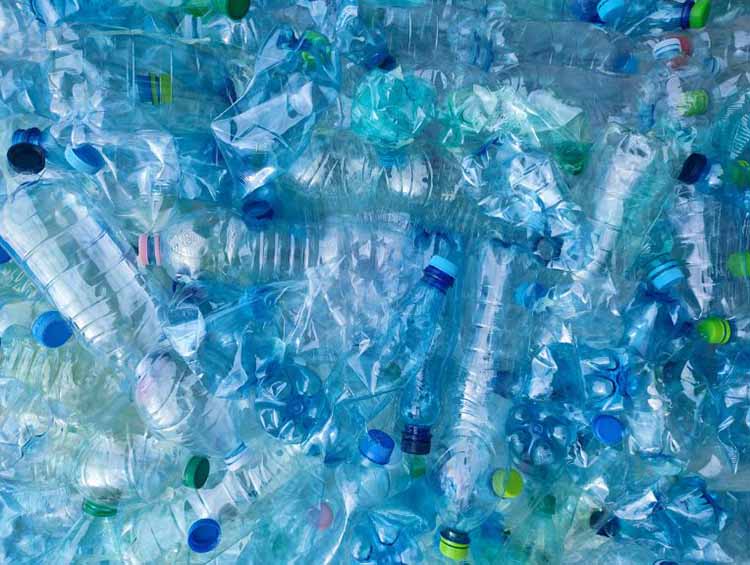
Recommended: Clear Plastic Water Bottles
How Are Plastic Water Bottles Made?- 3 Different Ways
There are different ways how plastic water bottles are manufactured. Let’s get to know about them.
1. Injection Blow Molding
The injection blow molding (IBM) process is used toused to mass-produce hollow plastic bottles
This process involves three stages.
- First, melted plastic is injected into a mold cavity to form a preformed parison, which resembles a test tube with a molded screw top.
- In the second stage, the preform is transferred to the blow molding phase, where the air is blown through a core pin to expand the preform against a cold mold chamber.
- Finally, the formed container is moved to the third station for ejection.
Advantages
- Injection blow molding ensures bottles have uniform thickness and intricate detailing. This fact makes it ideal for industries such as cosmetics and pharmaceutical industries where accuracy and appearance are essential.
- This technique can be largely automated, enabling the production of large quantities of bottles quickly. It helps lower production costs and boost efficiency.
Disadvantages
- The initial tooling expenses for injection blow molding are higher than those for other methods, making it more cost-effective for large production runs rather than smaller batches.
2. Extrusion Blow Molding
Extrusion blow molding is another common method for manufacturing hollow plastic bottles, especially with thin walls and large capacities.
This process has three main stages: extruding a parison, inflating the parison into a preform, and blow molding the preform into the final bottle shape.
Advantages
- This method can produce large volumes of bottles with minimal material waste. Its high level of automation helps to reduce labour costs and improve production efficiency.
- Extrusion molding can create bottles with complex shapes and detailed designs. However, the size and shape of the mold can limit the final design, although extrusion blow molding effectively handles larger molds.
Disadvantages
- Variables such as mold temperature, cooling rate, and blow pressure can influence the quality of the bottles, requiring careful monitoring and adjustment. This process has a higher potential for errors compared to other molding techniques.
3. Stretch Blow Molding
The stretch molding process is widely used to create plastic bottles for water, carbonated drinks, and other beverages. This method involves stretching a preform of molten plastic into the final bottle shape using a combination of heat and pressure.
The process consists of two main stages: placing a preform into an injection molding machine and stretching it into the final bottle shape.
Advantages
- Produces lightweight bottles with excellent barrier properties
- Protects contents from oxygen and moisture
- Ideal for the food and beverage industry, where product aesthetics and preservation matter.
Disadvantages
- High initial tooling costs, only suitable for large-scale production runs
- The most expensive and complex plastic bottle manufacturing process.
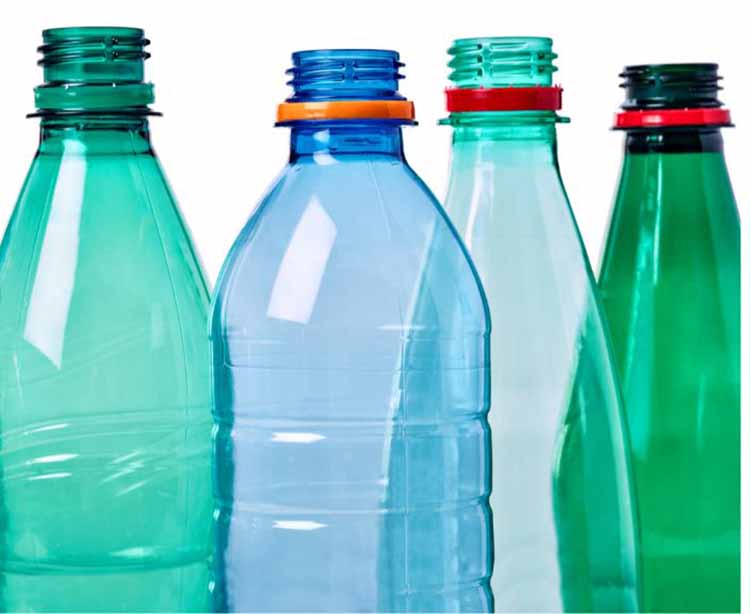
Recommended: Best Insulated Water Bottles With Handles
Step-by-Step Process of Manufacturing Plastic Water Bottles
Since you know all the basics of the creation of plastic water bottles, you’ll find this step-by-step process easy to understand.
Step 1: Raw Material Preparation
The primary raw materials for plastic bottles are petrochemicals. These materials are refined into ethylene or propylene. Manufacturers then convert these chemicals into plastic pellets, forming the base material for bottle production.
Step 2: Melting the Plastic
In this step, manufacturers melt the plastic pellets and extrude them into long tubes using an extruder machine. These tubes are then cooled and cut into shorter segments, known as preforms. These pieces are smaller and initial versions of the final bottles.
Step 3: Injection Molding
During the injection molding stage, manufacturers reheat the preforms and place them into molds. After that, manufacturers shape them into the desired bottle form. Once the mold cools, the preform is ejected, which is now in the shape of the final bottle.
Step 4: Blow Molding
The preformed bottles are then transferred to a blow molding machine. Here, the preforms are clamped in place, and compressed air inflates them to the final bottle shape. This step ensures that the bottle walls are even and uniformly thick.
Step 5: Inspection and Quality Assurance
Manufacturers then trim off any excess material and inspect the bottles for defects or imperfections. This step is a must to ensure the bottles meet all quality and safety standards.
Step 6: Labeling and Packaging
After inspection, the bottles are labeled with essential product information, including brand name, product name, and ingredients. Finally, they are packaged and prepared for distribution to customers.
Environmental Impact of Plastic-Making Process
The environmental impact of the plastic-making process is a long horror story.
It begins with the extraction of petrochemicals (primarily from crude oil and natural gas), which contributes to habitat destruction and pollution. The manufacturing process itself is energy-intensive, meaning it’s responsible for large amounts of greenhouse gases that contribute to climate change.
Additionally, the production of plastic generates hazardous waste and pollutants, including volatile organic compounds (VOCs) and particulate matter. It can further harm air quality and public health.
This is not the end; plastic waste is another major concern. A huge portion of plastic products ends up in landfills or the natural environment, where they can take hundreds of years to decompose.
Microplastics are tiny pieces of broken-down plastic found in oceans, soil, and even drinking water. They can harm animals and plants and might even affect our health.
Recommended: Best Green Water Bottles
FAQs
How Are Plastic Bottles Transported?
Plastic bottles are securely sealed to keep their contents safe from the environment from production to consumption. These sealed bottles are transported by trucks, ships, or trains. This transportation method helps maintain the quality and safety of the bottled water throughout its journey.
How Many Times Can You Drink Out of A Plastic Water Bottle?
You can drink out of a plastic water bottle a few times, but it’s best to use them only once. Over time, the plastic can degrade and release chemicals. Bacteria build-up inside the bottle is another big concern. For safety, it’s best to use a reusable bottle of safer materials for multiple uses.
Last Words
We’re done with the answer to ‘How are plastic water bottles made?’
We hope that the answer helped you gain enough knowledge regarding the manufacturing process of plastic water bottles. There are several steps included. Manufacturers start by selecting raw materials like PET and polymerize the materials. Then, the plastic is melted and formed into preforms. These preforms are heated and shaped into bottles using blow molding.
After cooling, the bottles are inspected for quality, labeled, and packaged for distribution. That’s it!

